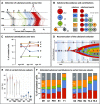Dynamic clonal hematopoiesis and functional T-cell immunity in a supercentenarian
- PMID: 33184493
- PMCID: PMC8257492
- DOI: 10.1038/s41375-020-01086-0
Dynamic clonal hematopoiesis and functional T-cell immunity in a supercentenarian
Conflict of interest statement
The authors declare that they have no conflict of interest.
Figures


References
Publication types
MeSH terms
LinkOut - more resources
Full Text Sources
Other Literature Sources
Medical

